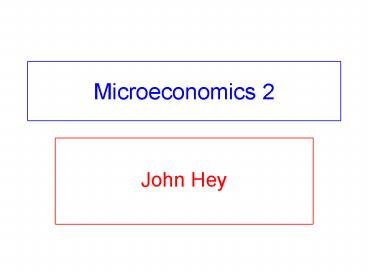Microeconomics 2 - PowerPoint PPT Presentation
1 / 13
Title:
Microeconomics 2
Description:
Microeconomics 2 John Hey Lecture 26: The Labour Market The supply of labour (consumer: leisure time/money trade-off). The demand for labour (theory of the firm). – PowerPoint PPT presentation
Number of Views:693
Avg rating:3.0/5.0
Title: Microeconomics 2
1
Microeconomics 2
- John Hey
2
Lecture 26 The Labour Market
- The supply of labour (consumer leisure
time/money trade-off). - The demand for labour (theory of the firm).
- Equilibrium.
- Minimum wage legislation.
- Two questions for you
- Does an increase in the wage rate imply an
increase in the supply of labour? Is it therefore
a good idea to reduce income tax (Mrs T and next
lecture) - Is minimum wage legislation a Good Thing? (old?
Labour) - Last year there was no question on this chapter
in the examination. This year there will be.
3
The supply of labour
- We use the analysis of Chapter 6 (Supply and
Demand with income in the form of endowments) - The space (l,m)
- l leisure time in hours (Initially L24 hours)
- m money (to spend on) consumption (Initial
holding M could be zero) - w is the wage rate per hour
- Budget constraint is m M w(L-l)
- The supply of labour L-l
- ...depends upon the preferences.
- Obviously both money/consumption and leisure time
are desirable (both are goods). - Let us go to Maple
4
The demand for labour
- We use the analysis of Chapters 11, 12 and 13
(Theory of the Firm/Production). - We use a space with Ld (the demand for) labour on
the horizontal axis and the Cost and total
Revenue of the firm on the vertical axis. - We keep things simple by assuming that we are in
the short run (capital fixed) with fixed costs
equal to 5, and the wage fixed at 1 per unit. - Total costs are fixed costs plus labour costs
(linear in labour). The slope is the wage rate. - Total revenue is the price of output multiplied
by the output produced and so is concave. - The slope of this curve is the price of output
multiplied by the marginal product of labour.
5
(No Transcript)
6
Total revenue and costs
- Note crucially that the cost curve (the red line)
is linear because the only variable input is
labour (capital is fixed). - Its slope is the wage rate w.
- The revenue curve is concave as capital is fixed
and the rate at which revenue increases is the
value of the marginal product of labour (which is
decreasing as output goes up since capital is
fixed). - The slope of the revenue curve is the value of
the marginal product of labour. - Which (for a competitive firm) is equal to the
price of output multiplied by the marginal
product of labour. - Let us go back to Maple...
7
(No Transcript)
8
The optimality condition for the demand for labour
- The slope of the total cost curve must be equal
to the slope of the total revenue curve. - The slope of the total cost curve is equal to the
wage rate. - The slope of the total revenue curve is equal to
the price of output multiplied by the marginal
product of labour. - Hence the optimality condition the real wage
rate (the wage rate divided by the price of
output) must be equal to the marginal product of
labour.
9
(No Transcript)
10
(No Transcript)
11
A minimum wage?
- What happens in this market if the government
introduces a minimum wage? - Obviously at a level higher than the equilibrium
wage in the competitive market.
12
(No Transcript)
13
Chapter 26
- Goodbye!





























